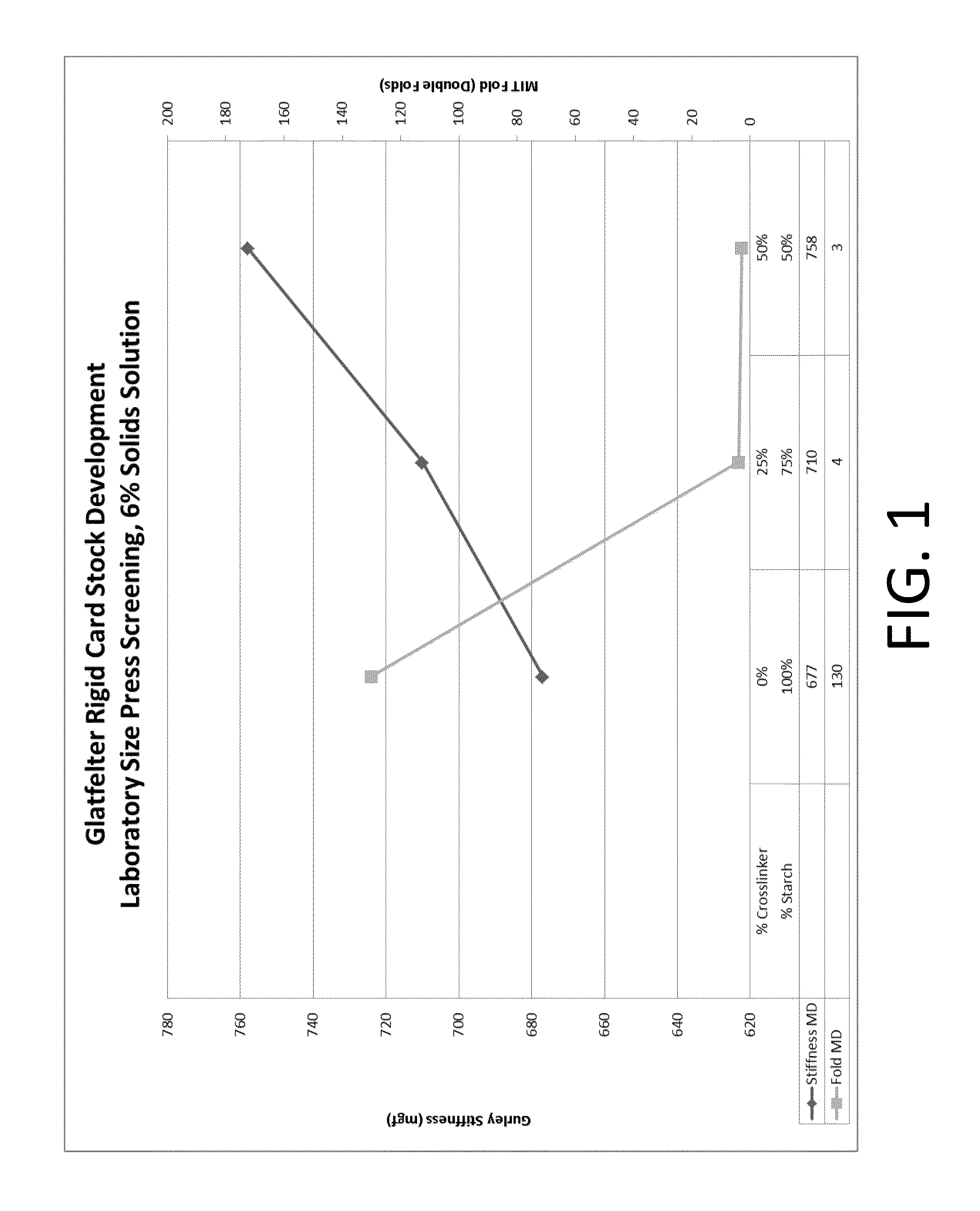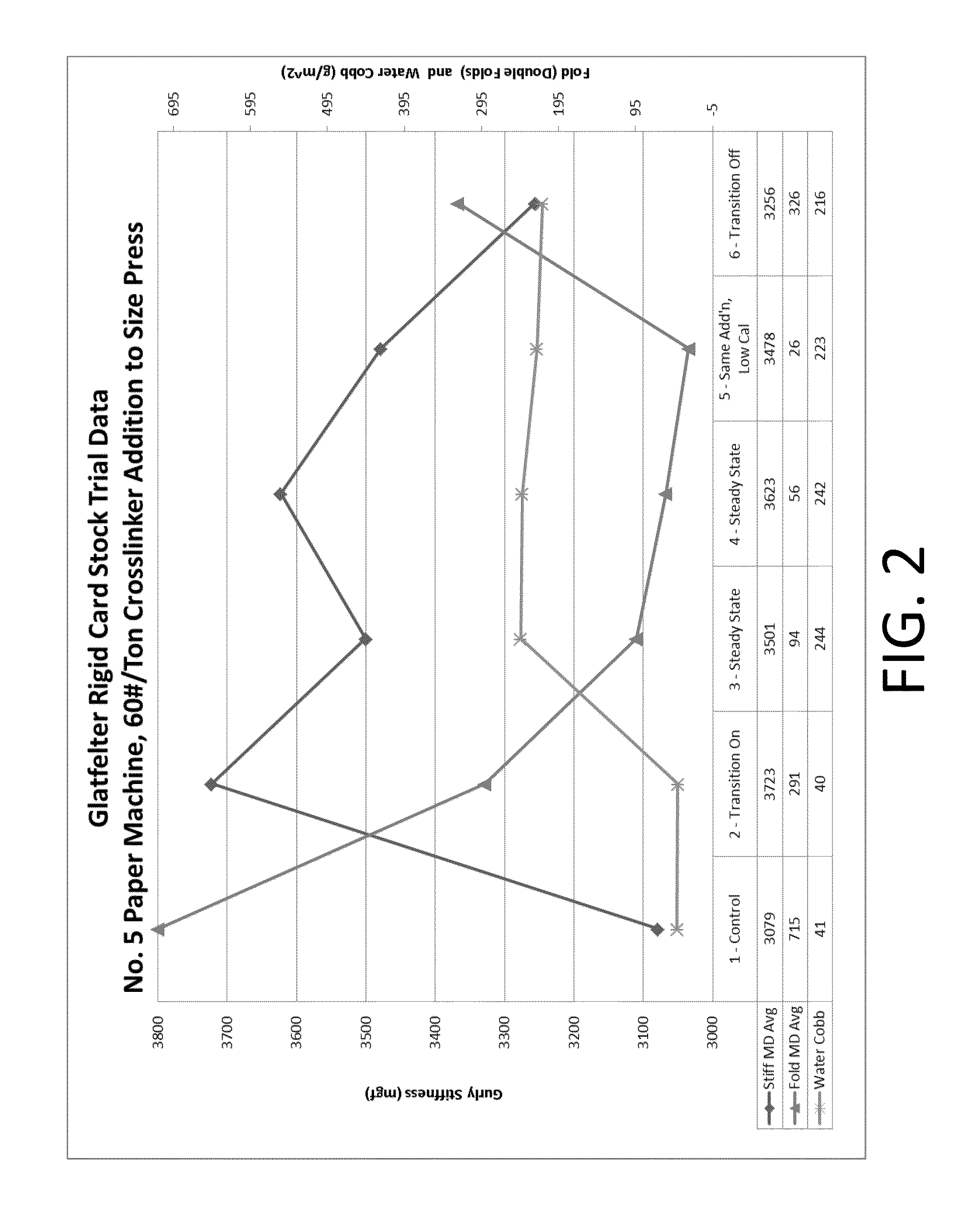Process for making a stiffened paper
a paper and papermaking technology, applied in papermaking, non-fibrous pulp addition, reinforcing agent addition, etc., can solve the problems of poor dry strength of paper produced from recycled fibers of shorter lengths, poor mechanical properties of paper produced from recycled fibers, etc., to improve mechanical properties, increase rigidity, and improve the effect of mechanical properties
- Summary
- Abstract
- Description
- Claims
- Application Information
AI Technical Summary
Benefits of technology
Problems solved by technology
Method used
Image
Examples
example 1
[0041]A first sample set was tested with a target refining freeness of 200 ml C.S.F. and a target basis weight of 65 lbs / 3000 ft^2. The following sample processes were tested:[0042]A1: A control paper product manufactured by adding only 60 lbs of PENFORD GUM 290 hydroxyethyl starch per ton of dry paper pulp at the size press.[0043]A2: A paper product manufactured by adding 60 lbs of PENFORD GUM 290 hydroxyethyl starch per ton of dry paper pulp at the size press and 6 lbs POLYCUP 172 polyamide-epichlorohydrin crosslinker at the couch roll.[0044]A3: A paper product manufactured by adding 60 lbs of PENFORD GUM 290 hydroxyethyl starch per ton of dry paper pulp at the size press and 6 lbs of CURESAN 200 Glyoxal-containing crosslinker per ton of dry paper pulp at the couch roll.[0045]A4: A paper product manufactured by adding 60 lbs of PENFORD GUM 290 hydroxyethyl starch per ton of dry paper pulp at the couch roll and 60 lbs of CURESAN 200 Glyoxal-containing crosslinker per ton of dry pap...
example 2
[0053]Another sample set was tested with a target refining freeness of 350 ml C.S.F. and a target basis weight of 115 lbs / 3000 ft^2. The following sample processes were tested:[0054]B1: A control paper product manufactured by adding only 60 lbs of PENFORD GUM 280 hydroxyethyl starch per ton of dry paper pulp at the size press.[0055]B2: A paper product manufactured by adding 30 lbs CELVOL 165S polyvinyl alcohol to the pulp slurry and 60 lbs of PENFORD GUM 280 hydroxyethyl starch per ton of dry paper pulp at the size press.[0056]B3: A paper product manufactured by adding 50 lbs of CELVOL 165S polyvinyl alcohol per ton of dry paper pulp to the pulp slurry and 60 lbs of PENFORD GUM 280 hydroxyethyl starch per ton of dry paper pulp at the size press.[0057]B4: A control paper product manufactured by adding only 60 lbs of PENFORD GUM 280 hydroxyethyl starch per ton of dry paper pulp at the size press.[0058]B5: A paper product manufactured by adding 25 lbs of CMC 7MCT carboxymethylcellulose...
example 3
[0068]A further sample set was tested with a target refining freeness of 500 ml C.S.F. Two target basis weights were tested for this sample set: a first subset including samples C1-C6 with the target basis weight of 165 lbs / 3000 ft^2 and a second subset including samples C7-C9 with the target basis weight of 65 lbs / 3000 ft^2. The following sample processes were tested:[0069]C1: A control paper product manufactured by adding only 60 lbs of PENFORD GUM 280 hydroxyethyl starch per ton of dry paper pulp at the size press.[0070]C2: A paper product manufactured by adding 60 lbs of PENFORD GUM 280 hydroxyethyl starch per ton of dry paper pulp at the size press and 6 lbs of CURESAN 200 Glyoxal-containing crosslinker per ton of dry paper pulp at the couch roll.[0071]C3: A paper product manufactured by adding 60 lbs of PENFORD GUM 280 hydroxyethyl starch per ton of dry paper pulp at the size press and 200 lbs of CURESAN 200 Glyoxal-containing crosslinker per ton of dry paper pulp at the couch...
PUM
| Property | Measurement | Unit |
|---|---|---|
| weight percent | aaaaa | aaaaa |
| pH | aaaaa | aaaaa |
| length | aaaaa | aaaaa |
Abstract
Description
Claims
Application Information
 Login to View More
Login to View More - R&D
- Intellectual Property
- Life Sciences
- Materials
- Tech Scout
- Unparalleled Data Quality
- Higher Quality Content
- 60% Fewer Hallucinations
Browse by: Latest US Patents, China's latest patents, Technical Efficacy Thesaurus, Application Domain, Technology Topic, Popular Technical Reports.
© 2025 PatSnap. All rights reserved.Legal|Privacy policy|Modern Slavery Act Transparency Statement|Sitemap|About US| Contact US: help@patsnap.com


